
The cultural convergence of the two diverse worlds of fine art and mechanical timepieces is gaining momentum with more and more artists sharing their enthusiasm for horology through unique watch-inspired artworks
Watches and art — it’s remarkable how these two diverse worlds of collectibles have been influencing each other for years now. As wristwatches evolved from being just functional tools in the early 20th century to becoming mechanical ‘works of art’ with romantic notions of beautiful, handmade timepieces gaining popularity in the 1950s, the two fields started to inspire artists and watchmakers to confluence in more ways than one.
Today, if you look up #watchart, you will discover many artists in the digital world whose works are inspired by watchmaking. Even though it’s tough to capture the enormous talent brewing in the contemporary watch-art scene in its entirety, we reached out to some of the leading names for our two-part series The Art of Time.
From watch and type designer @onehourwatch, whose niche is a time limit of an hour to create watch drawings to crochet artist @ponymctate, who crochets watches, particularly Rolexes (she calls ‘em #cRolex), we caught up with a few artists to know more about their unique horology-inspired artworks, inspirations and personal watch collections.
Bjoern Altmann | @bjoernaltmann
If you glance through Bjoern Altmann’s Instagram feed, you’ll definitely be taking a second look as his illustrations are super clean, realistic and absolutely captivating. London-based graphic designer Altmann was inspired to make #watchart by his dad, who used to collect watches. “I remember when I was 17, I worked in a garden once a week to be able to buy a Bulova Automatic by Benetton. Much later, I came across the Omega Dynamic and thought the bull’s eye dials looked amazing. I thought it would be nice to create a line-up of just the dials, so I recreated them in Adobe Illustrator to study them.”
Altmann, who specializes in font design and illustration, notices all the details of an object when drawing, and that’s true for watches as well. “When it comes to typography, it was all done by hand in the old days. With the many digital fonts readily available, people often forget to look at the details and to create letters and numerals from scratch, just for the watch. They form an integral part of a dial and are as important as all the other parts of the watch. These illustrations help my understanding of a watch’s dial design.”
Ideating and creating the art piece, as with a real watch, depends on the complexity of the piece. “It can range from two days for a Cartier Crash to a week for something like the Zenith Chronomaster,” says Altmann.
Since he started drawing watches in 2016, now more than ever, Altmann’s been looking closely at the details of a watch, “so some watches I wouldn’t buy because of the poor typography.” He adds “I think watch brands are sometimes missing a trick by not investing in that space.” Recently, he’s been focusing on quite a few Cartier illustrations after discovering Francesca Cartier Brickell’s The Cartiers: The Untold Story of the Family Behind the Jewelry Empire. He found it fascinating and said, “it led me to explore the different shapes of Cartier watches.”
Pony McTate | @ponymctate
Here’s a little something different. From the list of artists we’re covering today, this one’s by far the most textured and one you can probably even wear, quite literally. I mean, who needs a Rolex when you can just get a #cRolex, right? New Zealand-based crochet artist Pony McTate started making crocheted watches when she realized she had to change the misguided narrative about crochet—that it is homely, or unsophisticated, or ugly. “Rolexes have a narrative all of their own. They’re interesting because they’re mass-produced but retain this aura of aspirational luxury. And they’re instantly recognizable beyond the horology crowd.”
From a design point of view, “watches are an artform all in themselves. They are such a small canvas, and there’s so much meticulous componentry packed in there, even before aesthetics come into play. As a result, every detail, every line, every texture has a significant impact on the overall appearance.”
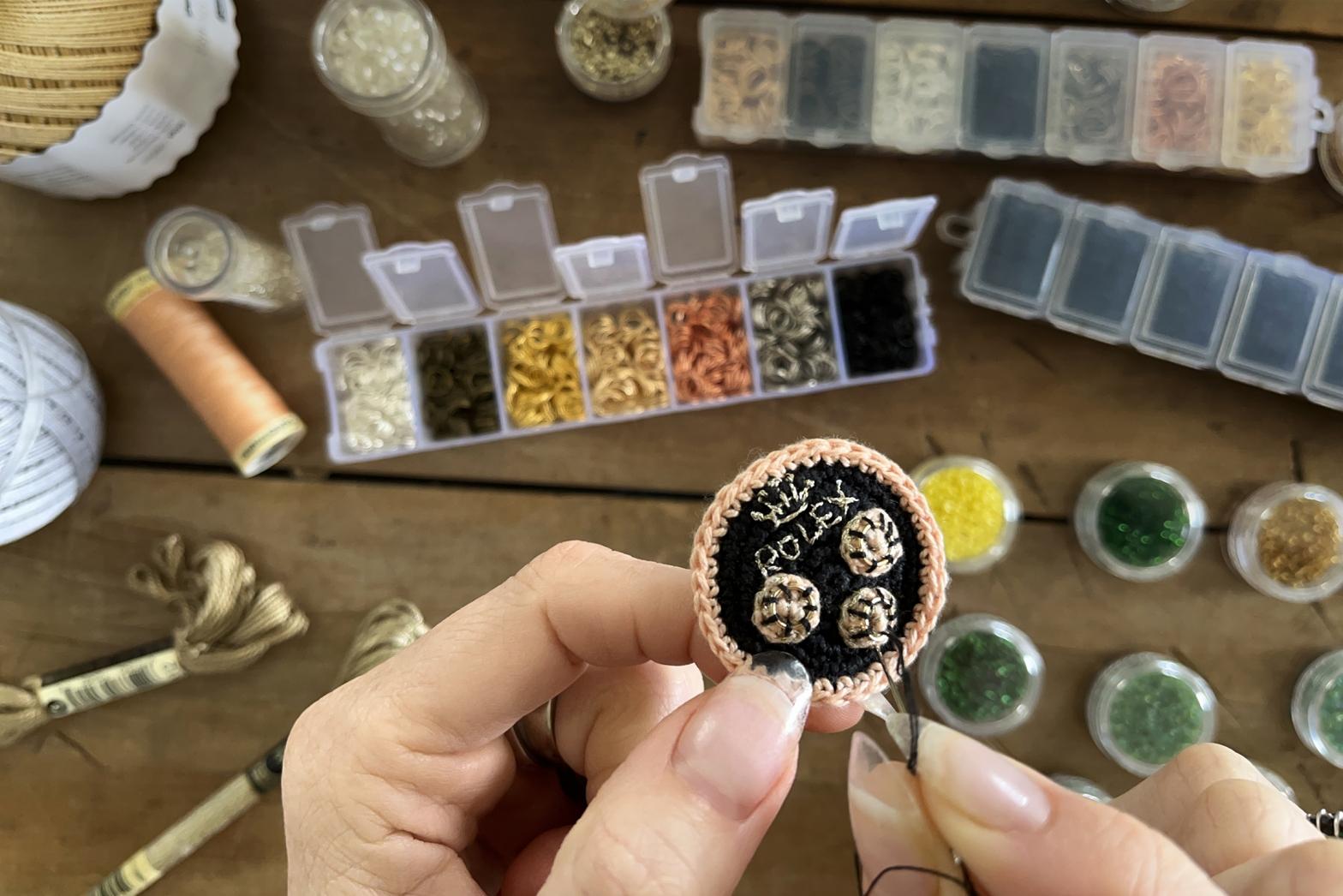
McTate wasn’t particularly interested in watches until quite recently, when she started crocheting them. “At the time, I couldn’t pronounce Audemars Piguet, let alone recognize one. So the learning curve was pretty steep. The crochet watch that kicked it all off for me was a Rolex Rainbow Daytona Everose, so that one will always have my heart. It is so completely over the top and so polarizing. I love it.”
To date, McTate has been making her watches to order. The research and early prototyping takes hours but that’s also when her creative energy is at its highest, so time for her tends to whizz by. “Crochet is one of the few textiles that can’t be recreated by machine, so every time you see it, someone’s labored by hand, loop by loop by loop. A watch and its box takes me between two and three weeks, depending on the model. Stitching the face is my favorite aspect; it is when it all comes together,” she says.
Laborious but a fruit of hard work, McTate feels that the time it takes to create something handmade like this can be baffling to people who are conditioned to Amazon next-day delivery. “Some of my watch clients benefit from a gentle reminder. Repeating the same model 12 times in a row can get rather monotonous too, so I take breaks from my watch series to recharge my creativity. There’s an ongoing joke amongst my fanbase that the waitlist for my Rolexes rivals that of the real thing.”
Patcharavipa Bodiratnangkura | @patcharavipa
A jewelry designer with Thai roots, Patcharavipa Bodiratnangkura launched her own brand in 2016 and since then she has been working on not just jeweled accessories but watch customization as well. So far, her most notable project has been a custom-designed 1970s King Midas Rolex watch, which is now owned by none other than Rihanna. Before customizing this Rolex Midas, Bodiratnangkura worked on a sample piece with a broken vintage face for nearly five years. Once she was sure of the technique, she finally adorned the said Midas’ bracelet with a textured pattern. “ We never use a client’s watch for customization. We source our own watches, like we source the gem stones for our jewelry and then work around them,” says Bodiratnangkura.
Bodiratnangkura’s inspiration is deeply rooted in Thai culture. She likes working with raw, recycled, or organic materials like coconut shells and her designs depict a confluence of nature and fine jewelry. The way watches came into play thanks to her boyfriend, who loves watches, though the couple rarely wears one. Besides the Midas, Patcharvipa’s most enticing watch-inspired jewelry line includes a range of ‘ring-watches’ priced at around £18,000. “Most people wonder if the watch inside the ring actually works. We hunt down vintage watches to make these rings and they all work fine,” she says. “I love tiny things. We found this really tiny women’s wristwatch from the '70s and it was an actual Rolex. We treated it like it was a diamond and set it inside a ring. And you can see all the texture out there, like it’s a cave with a watch inside. It's my signature texture.”
.gif&w=4320&q=75)
Lee Yuen-Rapati | @onehourwatch
His Instagram username says it all – @onehourwatch a.k.a. Lee Yuen-Rapati’s niche is to draw watches within an hour. Inspired by watches from the 20th century, Lee fell in love with timepieces as an undergrad design student. “Watches inhabit a wonderful space that combines craft, history, industry, and, of course, creativity. I don't think watches should be seen from one viewpoint, even within the confines of looking at design. Certain watches shine due to their artistry, while others represent an immensely successful implementation of industrial thinking,” he says.
Using a technical style of drawing for watches, like detailed 2D sketches or diagrams, Lee says, it can be fun to experiment with more free-form or abstract designs, but it usually depends on what kind of image or work is being created. “Besides art, I feel creating typography for watches is definitely its own niche, with quite a few nuances that differentiate it from something like book typography or display type.”
Tamás Fehér | @darksideofthewatch
Aesthetically pleasing and different from digital illustrations, Hungary-based Tamás Fehér’s art pieces are all hand drawn. Much like Altmann, Fehér’s interest in the world of watches started in his childhood, as his father used to work as a jeweler and watchmaker. “I was always amazed by the complexity of these mechanical instruments, along with the beauty of different materials and finishes. The love of drawing also came early in my life.”
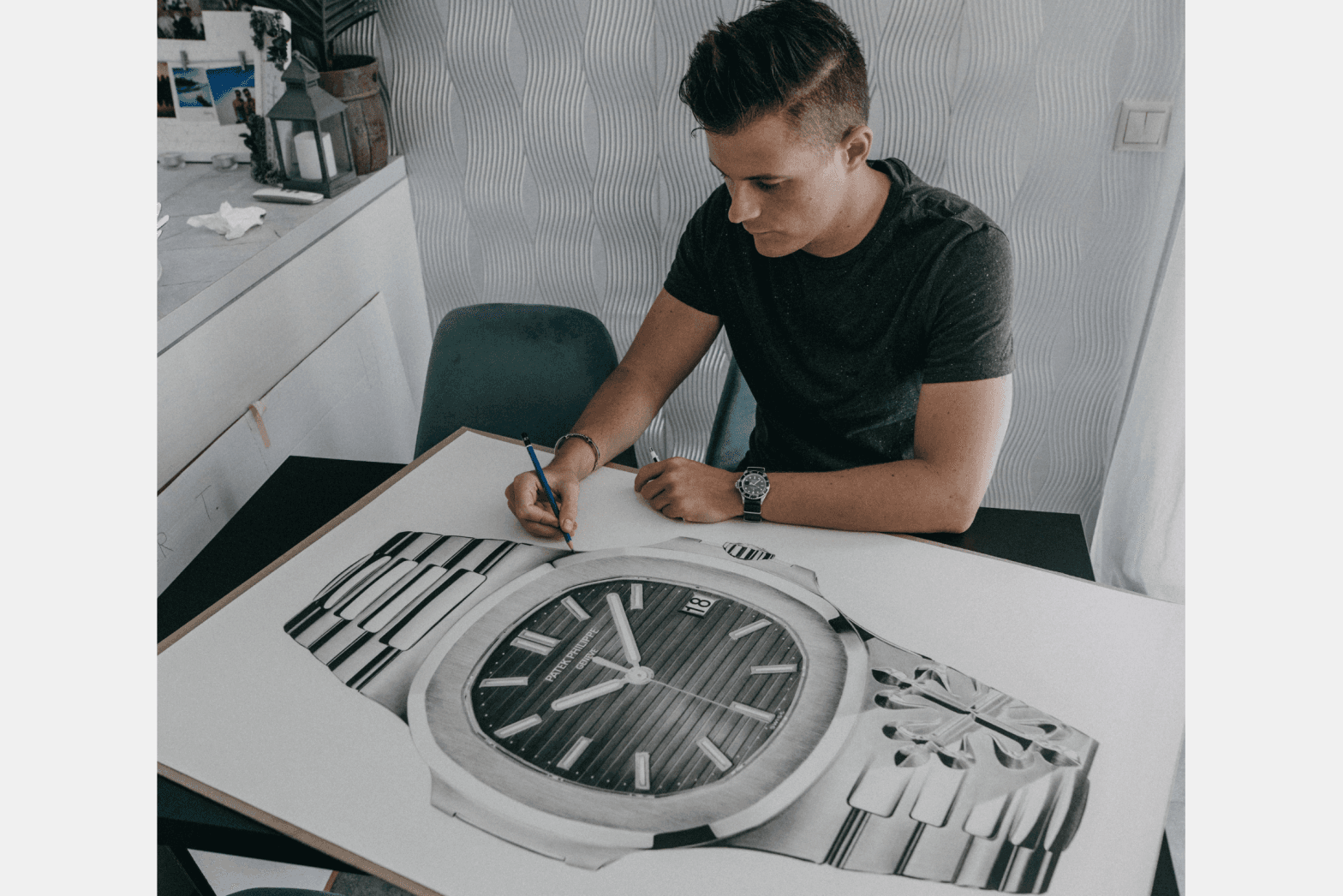
Why have “@darksideofthewatch” for a name, one might wonder. Fehér attributes it to his favorite album is the Dark Side of the Moon by Pink Floyd (we all love a good music reference, don’t we?). Scrolling through his feed, you’ll notice a dark, toned filter throughout his pieces. “I think graphite gives a nice dark tone to the watches on paper. I use many tools, but nothing special. My drawings are made in an old-fashioned way. Pencils, eraser, ruler and a compass. I use an old tablet to see the zoomed photo reference of watches. That’s the most high-tech tool I use” he says.
Working on relatively large big frame pieces, about 100x70cm, each artwork takesFehér approximately 100 hours of work, from start to finish. “These are tiny objects in real life, but in drawings they are huge. Watches are highly personal objects, especially vintage pieces which have many scratches and marks of wear on them. I have heard so many amazing stories from watch collectors, so I try to make my drawings personal as well. Sometimes I set the date on the watch to someone’s birth time or add a little engraving or hidden detail to the drawing. These objects mean a lot to their owners, as they often remind them of a special time or a special someone.”
Wing Choi | @illuswatch
A recent entrant into watches, Wing Choi a.k.a. @illustwatch’s first encounter with timepieces happened around two years ago when her partner bought his first luxury watch – a Rolex Yachtmaster Ref. 16622. “Starting #watchart was totally unintentional. One day, I picked up my iPad and decided to draw it as a gift for him. The act reignited my love for illustration, as well as sparked an interest in watches in general,” Choi says, adding, “as I'm fairly new into horology as well as this type of art, I’m still consistently looking for different ways and ideas to bring my art to life and to elevate it to the next level, says Choi, who aims for a hyper-realistic approach. “At first glance, it might look like a photograph, but if you look closer, it is actually an illustration,” she says.
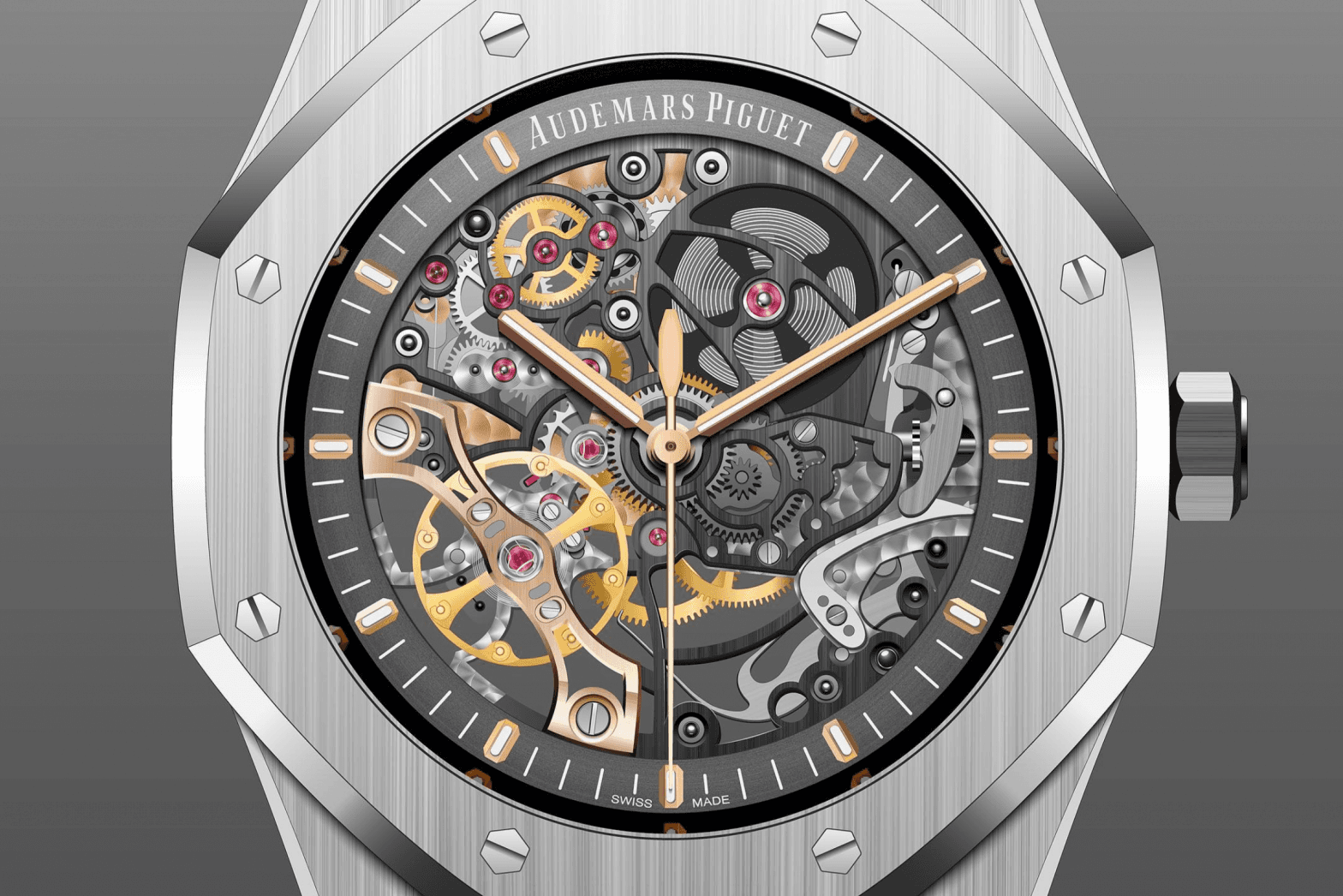
Each piece, depending on the complexity, can take anywhere between 50 hours and 160 hours. “Before I start to illustrate the watch, I gather as much information as possible to study the watch, which includes a lot of high-resolution images and macro-shots to gain a better understanding of the watch. Seeing the watch in the metal often brings out more details and characteristics that are hard to catch in pictures,”she says.
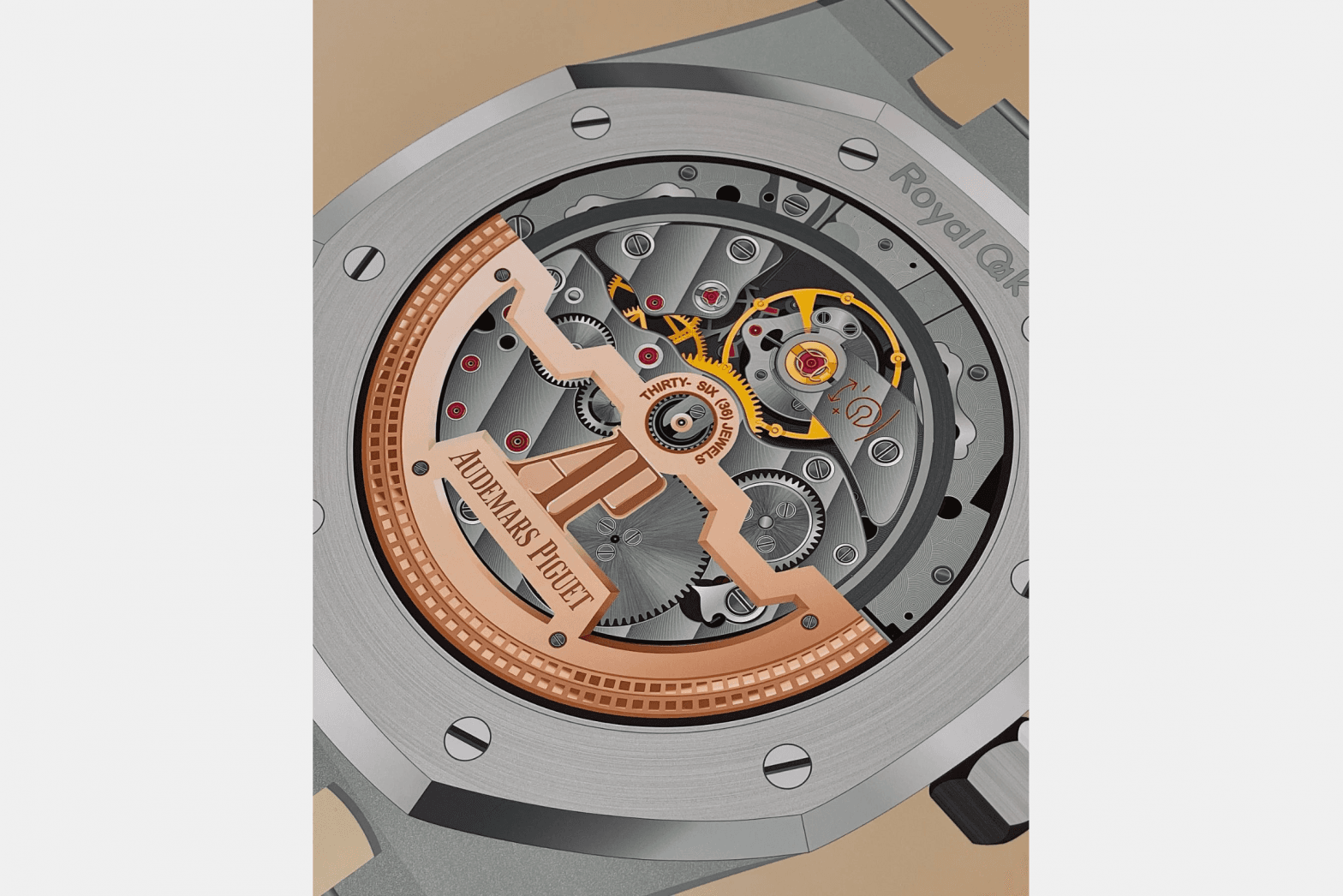
Choi is into watches not just as an artist but also as a collector. Her personal collection includes a 34mm Audemars Piguet Royal Oak Ref. 77350ST and a vintage Cartier Colisée Ref. 1980. Thanks to some of the commissioned artwork, she’s had the chance to explore other watch brands like F.P. Journe and A Lange & Söhne. “Those two caught my attention right away with their sophistication and yet simplicity.”
Estelle Lagarde | @lagardejewelrydrawing
Jewelry and watch designer Estelle Lagarde’s inspiration for creating art stems from her love for challenges and her passion for watchmaking. As watches are intricate and complex pieces, it takes a great eye and extreme precision to work on them. “Working on enameled dials teaches me to be patient.”
Lagarde uses a painting technique called “gouache”, which involves adding gum or a white pigment to watercolors to achieve opacity. Jewelry and watch designers have been known to use this method to create realistic and detailed references, which help in the final outcome of the painting. “To make a watch gouache at 1.5:1 scale, it takes about six days of painting. For a canvas, about two weeks. For the gouache painting, I use gray paper, soft brushes in Poil de Martre, as well as gouache.”
According to Lagarde, both jewelry and watch designs are very similar and it’s actually the mechanics that interests her the most. “What changes from one product to another is the way you approach the shadows, lights, and volumes. They’re all different, but the technique does not change. That's why it is interesting to work on new models each time, as it is a new interpretation of materials,” she says.
Romaric André | @secondeseconde
Steering into more of an abstract form of #watchart, we have Romaric André, who is breaking away from stereotypical descriptions of watches. As watches are associated with words like “meticulosity, luxury, prestige, excellence, precision," he thought "it was a sweet idea to penetrate those areas and “respectfully vandalize” watches. The fact that I started only by swapping watch-hands (not destroying anything) gave me the good feeling of being disrespectful and polite at the same time. I loved that mixed feeling. That wrong/right feeling is my main inspiration,” he says.
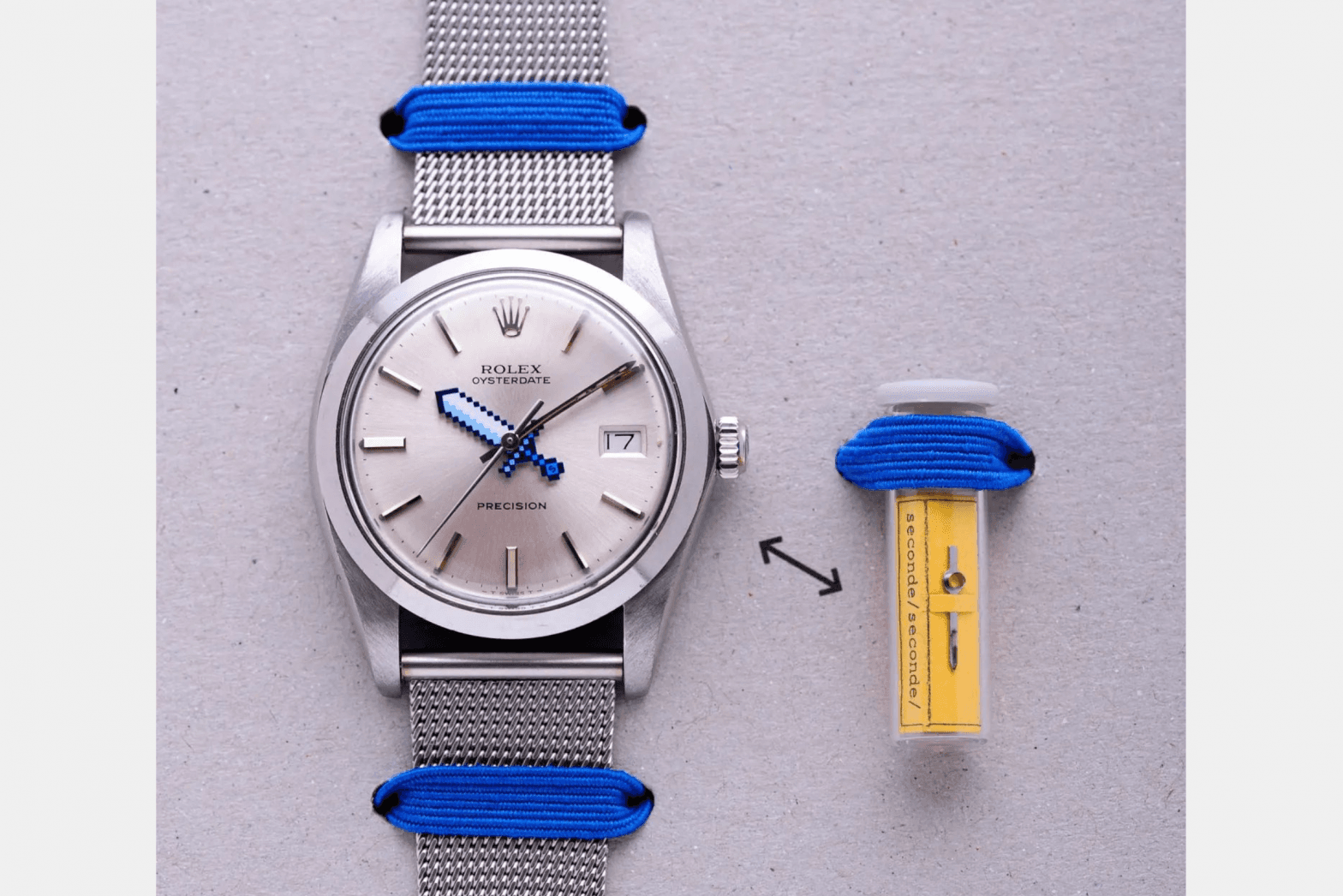
It can take André a minute, a month or even a year to come up with an idea but the manufacturing takes at least a few months for completion. “Watches are at the crossroads. They were born as utilitarian objects but they are not really utilitarian anymore.. They are fashion accessories but they are not only that. They are one of the biggest social status symbols but remain hidden under shirts. Watches are many things at the same time, so their design is under many different types of constraints. That’s interesting and constantly evolving.”
